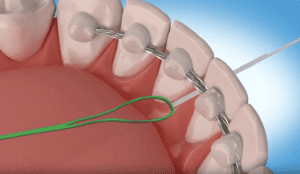A permanent retainer typically consists of a thin wire worn across the back of the lower or upper front teeth, which is bonded in place with a cement similar to that applied on the brackets of braces. While effective for maintaining alignment post orthodontic work, they do pose an obstacle for maintaining optimum oral hygiene, specifically when it comes to flossing.
Flossing with a permanent retainer doesn’t need to be a struggle. Instead, it can be an effortless routine once you grasp the technique. Retainers, while helpful in maintaining those straight and perfect smiles, may pose a challenge when it comes to cleaning. But, fear not, I’m here to introduce you to simple and efficient ways to maintain your pearly whites.
Before we delve into the flossing techniques, let’s understand what permanent retainers are. These are thin wires fixed behind the teeth to keep them in place post orthodontic treatment. Now let’s tackle the task at hand – flossing with these fixtures.
Use Floss Threaders
Floss threaders are an excellent aid for those with retainers. Threaders allow you to loop the floss and navigate around the retainer, reaching the gums underneath. It maintains the effectiveness of traditional flossing, so you don’t have to worry about compromising your dental hygiene!
Water Flossers Could Be Your Best Bet
A water flosser, or an oral irrigator, is a device that directs a powerful, thin stream of water to remove food particles and plaque between teeth and below the gum line. They are particularly efficient for those with braces, bridges, and yes, permanent retainers!
For those of you new to the concept of a permanent retainer, it is a thin wire secured behind the teeth to keep them in their ideal positions after orthodontic treatment. It accomplishes an excellent job at what it’s designed for, but it can also make flossing and thorough cleaning a tad bit challenging. This is where a water flosser can prove beneficial.
So, how does one go about flossing via a water flosser with a permanent retainer? Let’s break it down:
Fill the reservoir: Fill the water tank of the flosser with warm water. You can add an antibacterial rinse or mouthwash for an added freshness boost.
Choose Your Tip: Most Water Flossers come with multiple tip options. Choose one that suits your comfort.
Adjust the pressure: Start with a lower pressure setting and gradually increase it to a level that is comfortable for you.
Position the Tip: Lean over the sink to avoid splashes. Place the flosser tip in your mouth, close your lips to prevent splashing, and turn on the water flosser. It’s popular advice to start from the back and proceed forward.
Guide the tip along the gum line: Allow the flosser to pause briefly between teeth so that the water stream can effectively remove debris and plaque buildup. Make sure to guide the tip along the gums and beneath the retainer wire to ensure a thorough clean.
Remember, the water flosser is not a substitute for the ritual of daily brushing but an enhancement to your dental hygiene routine. Brushing your teeth twice a day with fluoride toothpaste is still as essential as ever!
In conclusion, a water flosser can be a game-changer for those with a permanent retainer. The convenience and efficiency it introduces for maintaining an optimal oral hygiene routine are commendable.
Use Super Floss
Super Floss is an ingenious tool specifically designed to make the process of flossing around dental apparatus, here a permanent retainer, considerably more accessible and efficient.
Super Floss consists of three unique components: a stiffened-end threader, spongy floss, and regular floss. The stiffened-end threader enables easy threading under retainers, bridges, and crowns. The spongy section is ideal for easing between the teeth and cleaning around all the dental nooks and crannies. Finally, the typical floss component aids in handling the areas closer to the gum-line to remove plaque.
So, how does one use Super Floss with a permanent retainer? First, take a piece of super floss and pass the stiffened end under the retainer wire. Once that is done, try to thread it between your teeth. Once it’s through, it’s time for the spongy floss area to shine. This spongy part serves to clean around the teeth and under the retainer wire effectively. Finally, gently pull the spongy floss under the wire and onwards to the regular floss section.
Remember, while Super Floss is exceptionally helpful, it’s not the be-all and end-all of your oral hygiene routine. Brushing twice a day using a good fluoride toothpaste, plus considering professional dental cleanings is still a must.
Mastering the technique of flossing with a permanent retainer may require practice but persist! A few days into this routine and it becomes another effortless addition to your dental care journey. Happy Flossing!
Interdental Brushes
These brushes work wonders for those hard-to-reach spaces. They are small, thin, and perfect to slide under the retainer wire to clean the teeth’s surface without any struggle.
To conclude, the main goal is to clean the spaces where your retainer wire and gums meet to be free of any funky bacteria. Brushing and professional cleaning at a dental office are also crucial in maintaining your oral health.
Remember, each technique has its merits, so consider your comfort and what your dental professional recommends. The key to mastering flossing with retainers, just like any other skill, is practice! Happy Flossing!



